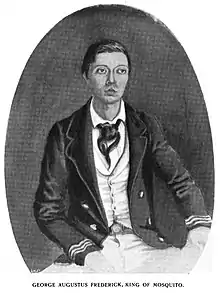House of Miskito
The House of Miskito, also called the Miskitu or the Miskut, was a noble family from the Miskito coast that came to reign over part of the current territories on the Caribbean coast of Honduras and Nicaragua between 1687 and 1894, under the Kingdom of Mosquitia. Their kingdom became a British protectorate and was one of the last existing ruling monarchies in the Americas.
| The Miskito Ulta Miskitu The Miskitu, The Miskut | |
|---|---|
| Royal house | |
 | |
| Country | Honduras, Nicaragua |
| Current region | Central America |
| Founded | 1620 |
| Founder | Ta Uplika |
| Final ruler | Robert Henry Clarence II |
| Final head | Norton Cuthbert Clarence |
| Titles |
|
| Dissolution | 1928 |
History
Origins

The current territories of Gracias a Dios (Honduras) and the Autonomous Regions of the North and South Atlantic (Nicaragua) have been inhabited by ancestors of the Miskito ethnic group since times prior to the conquest of the Americas, however the current territory of the Miskito coast was little explored by the Spanish due to its climate and deep jungles. The first conquest attempt was made by Hernán Cortes in 1525 after his landing in Honduras, upon hearing rumors of the existence of human settlements and a large city, which experts say was what is today the archaeological site of Kaha Kamasa.[1]
These efforts were in vain and the region remained almost free of Spanish presence. The Miskito tribes were guided through a political system of chiefdoms, however by the end of the 16th century a fusion of all the small chiefdoms was achieved.
It was at this time that trade relations were established with the English. The closeness with the English was so great that the future King Oldman was sent to England, where he was received in audience by Charles II in London, where, apart from being given a crown, he was named Oldman I of the Miskito coast. Many Miskitos converted to Anglicanism during his reign. After his death his successor was his son Jeremy I, who was also educated in England.[2]

The kingdom and the royal house remained relatively safe until the 19th century, when Spanish rule was overthrown in most of the Americas and the Miskito coast was claimed by the new Federal Republic of Central America. However, following the disintegration of the federation, on August 12, 1841, the superintendent of British Honduras and the Miskito monarch landed in San Juan del Norte and informed the Nicaraguan authorities that this city and the rest of what Nicaragua claimed as its Caribbean coast belonged to the Miskito kingdom.[3]
Disappearance

%252C_13th_King_of_the_Mosquito_Nationt.jpg.webp)
In 1860, Britain and Nicaragua signed the Treaty of Managua, according to which Britain recognized Nicaraguan sovereignty over the southern Miskito coast. In 1868, Honduras incorporated the northern Miskito coast, creating the department of Gracias a Dios.
_portrait.jpg.webp)
The Miskito kingdom would remain an autonomous region of Nicaragua until disappearing completely in 1894, when the government of José Santos Zelaya established direct rule, despite British protests. The last Miskito monarch was King Robert Henry Clarence, also known as Robert II, who died in 1908.
List of monarchs
- Ta Uplika (1620-1650)
- Oldman (1650-1687)
- Jeremy I (1687-1718)
- Jeremy II (1718-1729)
- Peter I (1729-1739)
- Edward I (1739-1755)
- George I (1755-1776)
- George II (1776-1801)
- George Frederic Augustus I (1801-1824)
- Robert Charles Frederic (1824-1842)
- George Augustus Frederic II (1842-1865)
- William Henry Clarence (1865-1879)
- George William Albert Hendy (1879-1888)
- Andrew Hendy I (1888-1889)
- Jonathan Charles Frederick I (1889-1890)
- Robert Henry Clarence (1890-1894)
Descendants
Some members of the Miskito Royal family fled Nicaragua after the abolition of the monarchy in 1894, most of them seeking refugee in Jamaica and other places of the Commonwealth of Nations. The best known case of a pretender to the crown attempting to reinstate the monarchy was Robert Frederic I, who died in 1928, at Aubrayeri, Wanks River, Honduras. With the death of Robert Frederic I it is said that the royal house was dissolved, however some descendants still live today, some claiming to be the representatives of the Miskito royal house.
Another descendant is the princess Mary Clarence, daughter of King Robert Clarence II. Another case of a pretender was Norton Cuthbert Clarence, who in 1978 claimed to be the last heir to the throne.[4] Other members of the Royal house are Velazco Hendy Oracio, Sean Henry Clarence, and José Miguel Coleman Hendy Clarence.
See also
References
- Ghotme, Rafat. El protectorado británico en la Costa Mosquitia (1837-1849). Revista de Relaciones Internacionales, Estrategia y Seguridad, versión impresa ISSN 1909-3063, Vol.7 No.1. Bogotá, Jan./June 2012. http://www.scielo.org.co/scielo.php?script=sci_arttext&pid=S1909-30632012000100003
- Bright, William (1986). "Ethnologue: Languages of the world Ed. by Barbara F. Grimes, and: Index to the Tenth edition of Ethnologue: Languages of the world Ed. by Barbara F. Grimes". Language. 62 (3): 698–698. doi:10.1353/lan.1986.0027. ISSN 1535-0665.
- A., Holm, John. The Creole English of Nicaragua's Miskito Coast : its sociolinguistic history and a comparative study of its lexicon and syntax. OCLC 701420751.
{{cite book}}: CS1 maint: multiple names: authors list (link) - Kessler, P. L. "Kingdoms of Central America - Kingdom of Miskito". The History Files. Retrieved 2022-10-02.